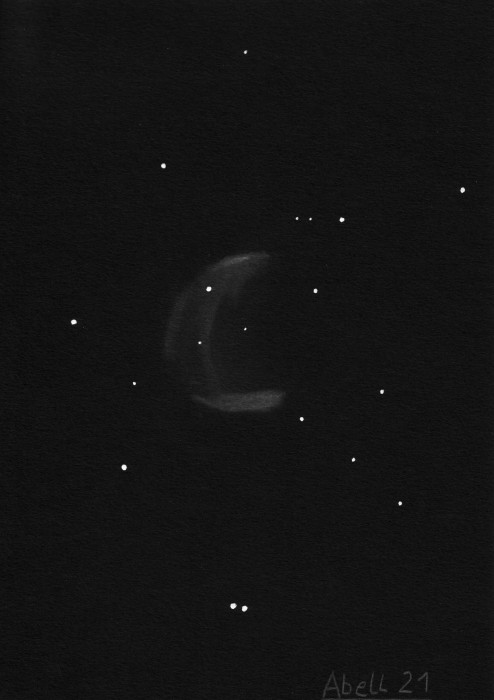Abell 21 (Medusa Nebula)
Gemini
RA 07 29 03
DEC +13 14 30
Type: large and ancient Planetary Nebula
Size: 12'x 9'
Abell 21 is one of those large and ancient PN that have expanded (and diluted) far into interstellar space such that their density is approaching that of the interstellar medium (ISM). The shape of the PN is therefore no longer governed by properties of its progenitor star (as in young PNe), but by its interaction with the ISM.
According to data by David Frew, Abell 21 is about 1800 LYs away, it has expanded to a diameter of roughly 3 LYs and is about 27 000 years old. Flux in OIII and H-alpha are comparable, so this is an object best viewed with OIII filter.
Abell21_DSS.jpg
Image of Abell 21 from the DSS
Abell21_NOAO.jpg
Extremely deep image by Heidi Schweikert and Travis Rector (NOAO) http://www.noao.edu/image_gallery/html/im1054.html
Similarly deep image by Ken Crawford http://www.imagingdeepsky.com/Nebulae/Medusa/Medusa.htm
Most of the large and ancient PN are extremely faint and require excellent conditions. Compared to these, Abell 21 is "reasonably" bright and under fair conditions not overly difficult. With my 22" Dob, it is visible also without filter (and it should also be with smaller aperture). Abell 21 is a bipolar PN. Due to its interaction with the ISM, Abell 21 appears lopsided at the telescope. The brightest section of the PN is its SE part that forms a crescent shaped shell with internal filamentary structure that is quite obvious at the eyepiece already in medium sized telescopes.
One step more difficult: Much fainter, but still detectable, is the interior of the PN. This interior of the PN is filled with a very faint glow visible with OIII filter. It enlarges the brighter crescent shaped part to a largely round shape.
And another step more difficult: Only during one night, I tried to trace the NW counterpart to the brighter SE crescent. This part is visible as a limb-brighened shell in the narrow band images. Under excellent conditions I suspected an extremely faint crescent with OIII filter that runs roughly parallel to a distinct chain of faint stars and beyond. Such chains of stars are deceptive, in particular in combination with emission line filters. Can anybody confirm sighting of this NW crescent?
Abell21_OIII.jpg
And finally the Holy Grail of Abell 21: Beyond this extremely faint NW crescent, there is further glowing gas visible in the very deep narrow band images. It is not clear whether this is material of the PN that had been stripped off while moving through the ISM or rather ISM itself being ionized by the White Dwarf central star of the PN. Assuming that the brighter SE side of Abell 71 is a bowshock due to movement of the PN through the ISM, this material would be on the "right side" to be a trail. Has anybody tried to observe this feature ? I did not even think of tackling this visually :-)




 Reply With Quote
Reply With Quote






